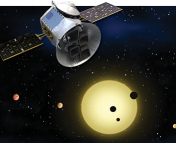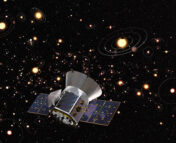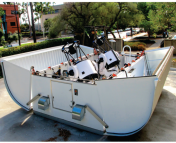Title: SO2 , silicate clouds, but no CH4 detected in a warm Neptune with JWST MIRI
Authors: Achrène Dyrek, Michiel Min, Leen Decin, Jeroen Bouwman, Nicolas Crouzet, Paul Mollière, Pierre-Olivier Lagage, Thomas Konings, Pascal Tremblin, Manuel Güdel, John Pye, Rens Waters,, Thomas Henning, Bart Vandenbussche, Francisco Ardevol Martinez, Ioannis Argyriou, Elsa Ducrot, Linus Heinke, Gwenael Van Looveren, Olivier Absil, David Barrado, Pierre Baudoz, Anthony Boccaletti, Christophe Cossou, Alain Coulais, Billy Edwards, René Gastaud, Alistair Glasse, Adrian Glauser, Thomas P. Greene, Sarah Kendrew, Oliver Krause, Fred Lahuis, Michael Mueller, Goran Olofsson, Polychronis Patapis, Daniel Rouan, Pierre Royer, Silvia Scheithauer, Ingo Waldmann, Niall Whiteford, Luis Colina, Ewine F. van Dishoeck, Göran Ostlin, Tom P. Ray, Gillian Wright
First Authors’ Institutions: Université Paris Cité, Université Paris-Saclay, CEA, CNRS, AIM, F-91191 Gif-sur-Yvette, France ; SRON Netherlands Institute for Space Research, Niels Bohrweg 4, 2333 CA Leiden, the Netherlands ; Institute of Astronomy, KU Leuven, Celestijnenlaan 200D, 3001 Leuven, Belgium
Status: published in Nature
At the moment of writing, there are 5,539 confirmed exoplanets. Unsurprisingly, there’s a wide range of possibilities: ranging from super-earths to gas giants dwarfing even Jupiter, there’s also planets where it … rains sand? The quick and dirty summary of today’s paper is this: using JWST, clouds made of sand were found on a hot neptune exoplanet. Of course, there’s a whole lot more coming along with this, so let’s dive into exactly how today’s authors arrived there. Firstly, one does not simply take a simple picture of an exoplanet like you would do with Earth and see some vaguely sandy clouds on there, not even JWST can do that. Instead, a method called transit spectroscopy is used: when the exoplanet passes over its star in our line of sight (or transits), the star’s light shines through the planet’s atmosphere. Then you can analyze the light with a technique known as spectroscopy to figure out what the atmosphere is made of. As the star is a whole lot brighter than the planet, any miniscule changes to the spectral light of the star due to the planet’s atmosphere are very hard to spot. Astronomers manage anyway, leading to clouds made of sand on a planet far away from our Sun.
Which planet are we talking about now?
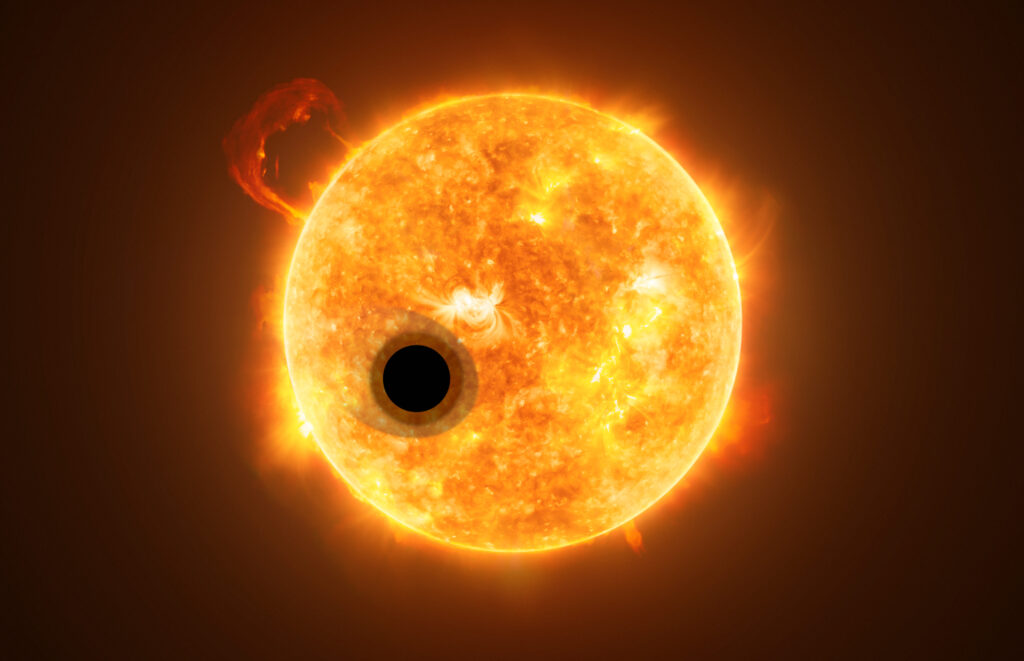
It’s called WASP-107b. Not the most attractive name, but a convenient one if you’re working your way through thousands of exoplanets (discovered with the Wide Angle Search of Planets, WASP) and naming all of them in a fun way is kind of eating up all your time, nice as it may be. The planet has a pretty high surface temperature of 740 K (about 467°C or 872°F) because of its proximity to its star. With about 30.5 times the mass of the Earth and almost Jupiter sized, this exoplanet is actually very light-weight – its huge size and low mass makes it very fluffy. Apart from undoubtedly being very cute, this also allows astronomers to look exceptionally deep into this planet and discover a whole lot of weird and interesting physics and chemistry. By being this large, the gravity on the outer layers of this planet is rather low. Also, being extremely close to its host star (0.057 AU, about 8 times closer than Mercury is to our Sun), the star’s radiation is actively blazing off the outer layers of this planet, which would give it a comet-like appearance (see also Figure 1).
What do your Astronomer-eyes see, Legolas?
Using JWST’s Mid Infrared Instrument (MIRI), the planet’s transit was captured in many different wavelengths over an extended period of time, as shown in Figure 2. Right in the dip of this light curve, as the planet is transiting the star, you can start figuring out something more about the planet itself. Through a complex process of data reduction, fitting algorithms and throwing away bad data points, you can sift out the imprint of the exoplanet on the star’s light. The authors used three different reduction strategies for this in order to independently arrive at the results, which are shown in Figure 3 (on top).
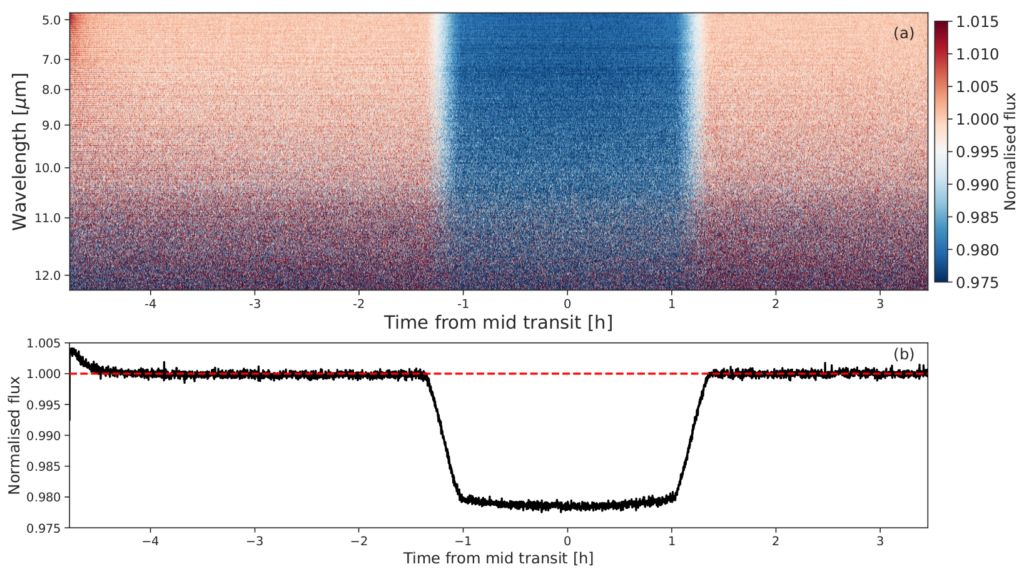
After this whole reduction process, the data you are left with now is how much light of the star is blocked by the planet’s atmosphere. And now the modeling can start. Why are these dips here, where do these peaks come from? Given a bunch of atoms and molecules in an atmosphere, how will the light of the star be blocked by it? Here’s where some hardcore chemistry and physics mixing (photochemistry) comes into play. Simulating some molecules you’d expect in these circumstances (and some less expected ones as well), the authors are able to build up the composition of WASP-107b’s atmosphere and ultimately simulate how the light of the star shining through your atmosphere will change. This is shown in Figure 3 (bottom), where strong features of water vapor, SO2 and silicate (a.k.a. sand) clouds were found. Adding these components, you get a simulated atmosphere that closely resembles what was observed with JWST.

The big surprise here is the presence of SO2. The SO2 molecule is only expected to form in large amounts above 1000 K, whereas this planet clocks in at 740 K. Another point is the presence of the silicate clouds: although this has been theorized to occur for planets like these, it is the first time there is conclusive evidence for sand clouds! You’ll need a whole different kind of windscreen wipers for the ‘rain’ coming out of these clouds (granted that you get a car across the 200 light years distance to this planet). Aside from these three components, other molecules like H2S, ammonia (NH3) and carbon monoxide (CO) were found with reasonable confidence as well. A notable absentee was methane (CH4), which is present in our Neptune (and Uranus), giving them their blue color.
These discoveries point in the direction of a very dynamic atmosphere, where a wide range of chemical reactions are still changing over time (in contrast with chemical equilibrium), giving rise to the unexpected presence of some of these molecules. This also means we now have a better view on how these atmospheres can form and, by extension, how these exoplanets can form in the first place.
Astrobite edited by Aldo Panfichi
Featured image credit: Illustration; LUCA School of Arts, Belgium/ Klaas Verpoest (visuals), Johan Van Looveren (typography). Science; Achrène Dyrek (CEA and Université Paris Cité, France), Michiel Min (SRON, the Netherlands), Leen Decin (KU Leuven, Belgium) / European MIRI EXO GTO team / ESA / NASA

